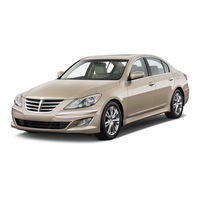Hyundai 2012 Genesis Manuals
Manuals and User Guides for Hyundai 2012 Genesis. We have 2 Hyundai 2012 Genesis manuals available for free PDF download: Owner's Manual, Quick Reference Manual
Hyundai 2012 Genesis Owner's Manual (430 pages)
Operation Maintenance Specifications
Brand: Hyundai
|
Category: Automobile
|
Size: 8 MB
Table of Contents
-
-
Seats21
-
Seat Belts22
-
Seats22
-
-
-
Headrest25
-
Seat Warmer27
-
Rear Seat30
-
Armrest32
-
SRS Care77
-
-
Key Number82
-
Horn91
-
Door Locks95
-
-
-
Windows102
-
Power Windows103
-
Hood Closing106
-
Hood Opening106
-
Fuel Filler Lid107
-
Steering Wheel116
-
Horn117
-
Gauges129
-
Speedometer129
-
Tachometer129
-
Fuel Gauge131
-
Trip Computer131
-
TRIP Button132
-
Odometer132
-
Tripmeter132
-
Maintenance132
-
DISP Button133
-
Average Speed134
-
Elapsed Time134
-
ECO Indicator137
-
Cruise Indicator144
-
ESC off Button144
-
LDWS Indicator145
-
Shift Lever148
-
-
Lighting156
-
Front Fog Light159
-
Interior Light164
-
Map Lamp164
-
Room Lamp165
-
Trunk Room Lamp165
-
Glove Box Lamp166
-
Welcome Light166
-
-
-
Defrost-Level172
-
Air Conditioning175
-
Rear Vent179
-
Defogging Logic181
-
Glove Box183
-
Sunglass Holder184
-
Ashtray185
-
Cup Holder186
-
Sunvisor186
-
Power Outlet187
-
Digital Clock188
-
Clothes Hanger190
-
Audio System194
-
FM Radio Station196
-
Care of Discs198
-
Using CD Player202
-
Usb205
-
Using USB Device206
-
Ipod207
-
CD Changer214
-
Phone Setup232
-
Pairing Phone232
-
Connecting Phone233
-
Deleting Phone233
-
Calling by Name236
-
Key Matrix238
-
-
-
Before Driving242
-
-
P (Park)251
-
D (Drive)252
-
N (Neutral)252
-
R (Reverse)252
-
Sports Mode253
-
Brake System257
-
-
Auto Hold264
-
-
ESC off Usage272
-
Driving at Night296
-
Smooth Cornering296
-
Highway Driving298
-
Snow Tires299
-
-
Winter Driving299
-
Vehicle Weight308
-
-
-
Road Warning311
-
-
Jump Starting313
-
Jumper Terminal313
-
-
Jack and Tools322
-
Changing Tires323
-
Towing330
-
Emergency Towing332
-
Maintenance335
-
Radiator Cap337
-
Air Cleaner343
-
Engine Coolant352
-
Brake Fluid355
-
-
Air Cleaner358
-
Battery366
-
Reset Items368
-
Tire Care369
-
Tires and Wheels369
-
Tire Rotation371
-
Tire Replacement373
-
Tire Maintenance374
-
Tire Traction374
-
Tread Wear377
-
All Season Tires381
-
Summer Tires381
-
Radial-Ply Tires382
-
Fuses383
-
Memory Fuse385
-
Main Fuse386
-
Light Bulbs394
-
Appearance Care403
-
Exterior Care403
-
Washing403
-
Waxing404
-
Interior Care407
-
-
-
Bulb Wattage414
-
Dimensions414
-
Specifications414
-
-
Engine Number420
-
Index424
Advertisement
Hyundai 2012 Genesis Quick Reference Manual (33 pages)
Brand: Hyundai
|
Category: Car Video System
|
Size: 3 MB
Table of Contents
-
DISC Mode
14 -
AUX Mode
18 -
Phone
21 -
Navigation
22 -
Info
30 -
Rear Camera
32
Advertisement

